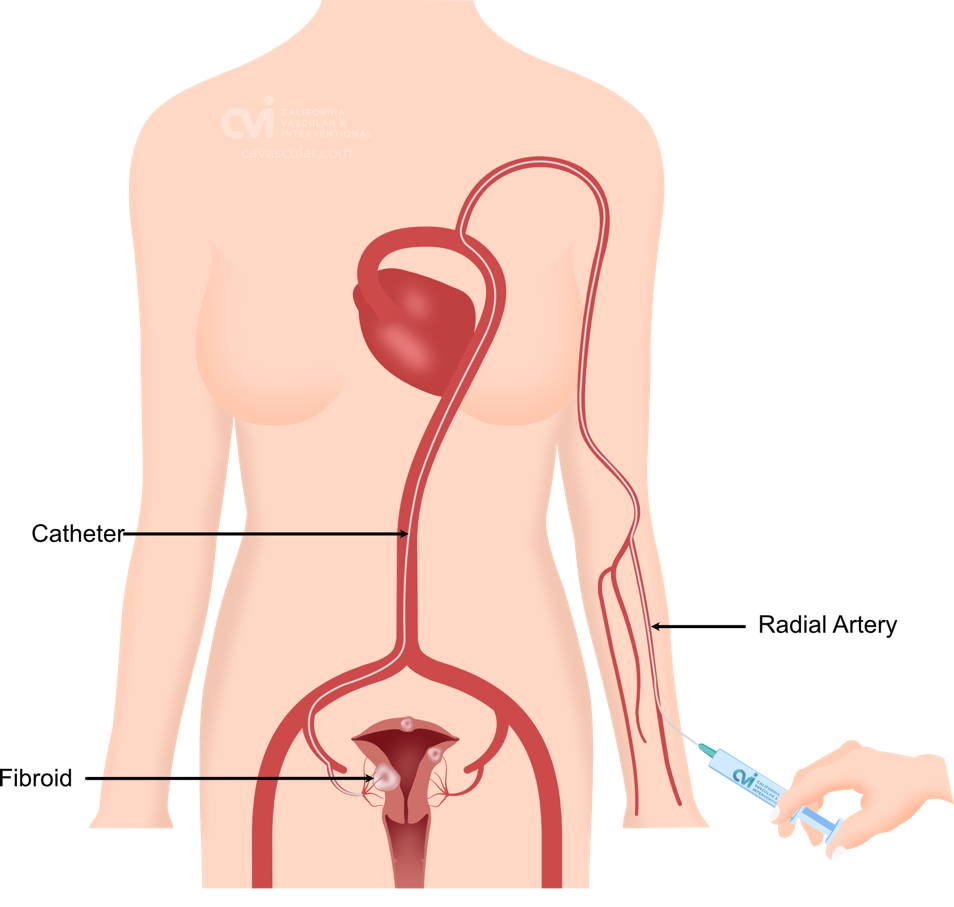Fibroids in Menopause and Treatment Options for Post-Menopausal Women
Fibroids, also known as uterine leiomyomas, are noncancerous growths that develop in the uterus. While fibroids are common during the reproductive years, their prevalence, symptoms, and treatment options may change during menopause. Most women with uterine issues in menopause are only offered hysterectomy, but other options may exist.
Fibroids in Menopause: Symptoms and Frequency
During menopause, a significant decline in estrogen and progesterone levels typically occurs, leading to changes in the uterus and fibroid behavior. While fibroids may stop growing or become asymptomatic for some women, others may continue to experience symptoms such as:
- Menstrual Bleeding: Menopausal women with fibroids may experience menstrual bleeding, although the frequency and intensity of bleeding will likely decrease. This may be an issue mainly for women that go on hormone replacement therapy who start experiencing menstrual cycles or spotting. Bleeding in menopause is not taken lightly and most women end up with a hysterectomy, something that they had been trying to avoid prior to menopause.
- Pelvic Pain: Fibroids can cause pelvic discomfort or pain, which may persist during menopause due to the presence of fibroids. This is the most frequent symptom we see reappear in menopausal women who were symptom free for many years. Symptoms can reappear many years after menopause.
- Urinary Symptoms: Fibroids can put pressure on the bladder, leading to increased frequency or urgency of urination. If you have large fibroids prior to menopause, this symptom will persist after menopause.
- Pressure Symptoms: Large fibroids may cause pressure on surrounding organs, leading to symptoms such as bloating, constipation, or discomfort. If you have large fibroids prior to menopause, these symptom may persist or reappear after menopause.
While fibroids do not grow after menopause, patients may continue to experience significant symptoms as above requiring intervention.
Request an Appointment
Please note that although we strive to protect and secure our online communications, and use the security measures detailed in our Privacy Policy to protect your information, no data transmitted over the Internet can be guaranteed to be completely secure and no security measures are perfect or impenetrable. If you would like to transmit sensitive information to us, please contact us, without including the sensitive information, to arrange a more secure means of communication. By submitting this form you consent to receive text messages from CVI at the number provided. Msg & data rates may apply. Msg frequency varies. Unsubscribe at any time by replying STOP.
Fibroid Treatment Options for Post-Menopausal Women
Post-menopausal women with symptomatic fibroids have several treatment options, including:
- Hysterectomy: Surgical removal of the uterus. This may not be ideal for older patients who may not recover from major surgery as well as younger patients. Older patients also have higher risks of surgical complications including DVT, pulmonary embolism, infection, anesthesia risks etc. Prior to any major surgery patients should be certain their symtpoms are due to their fibroids and should see evaluation by a UFE expert to see if a non-surgical treatment could be an option.
- Myomectomy: Surgical removal of the fibroid, while leaving the uterus behind. While this is an option for pre-menopausal patients, in menopause this is no longer a treatment option due to the risks of spreading or leaving behind pieces of tissue in the abdomen that could be cancerous.
- Endometrial Ablation: A procedure that burns the uterine lining to reduce menstrual bleeding. This does not reduce the size of the fibroids and only eliminates bleeding, thus this is not a good option for someone that needs fibroid volume reduction.
- Fibroid Embolization: A non-surgical procedure that blocks the blood supply to fibroids using a tiny catheter, causing them to shrink and alleviate symptoms without removing the uterus. This is ideal for high-risk surgical candidate or those that want to avoid surgery. However, not everyone is a candidate, especially if the fibroids are largely calcified. (read here about calcified fibroids)
Our Patient Experiences
Fibroid Embolization in Post-Menopausal Women: Success Rate as an Alternative to Hysterectomy
Fibroid embolization, also known as uterine artery embolization, may be a promising alternative to hysterectomy for post-menopausal women with symptomatic fibroids. This minimally invasive procedure involves inserting a catheter into the uterine arteries and injecting small particles to block blood flow to the fibroids.
Studies have shown that fibroid embolization is effective in reducing fibroid-related symptoms and improving quality of life in post-menopausal women. Research findings include:
- Improved Symptoms: A study by Smeets et al. (2018) demonstrated significant improvements in symptom severity and quality of life scores following fibroid embolization in post-menopausal women.
- Low Risk: Fibroid embolization is associated with low risks and shorter recovery times compared to hysterectomy, making it a safer and less invasive alternative for post-menopausal women who would be too high risk for surgery.
- Outpatient: UFE does not require any hospitalization, which is ideal for older patients who may otherwise be at risk for hospital acquired pneumonia, DVT, pulmonary embolism and other issues during prolonged bed/hospital stays.
Uterine Fibroid Embolization (UFE)
UFE can help you get your life back without any scarring or hospital stay. It can reduce the size of your fibroids, relieve your symptoms, and retain your fertility. Most women can return to their normal activities in two to seven days.
How is the UFE performed?
- You will receive twilight sedation to help you relax
- Our specialist numbs the skin on the wrist or groin
- A tiny catheter is placed
- Small beads are placed into the fibroid artery
- The catheter is removed
- Band-Aid is applied
- Recover at home


The patient is given a local and topical anesthetic to numb the skin and a mild sedative, so that the procedure is not
Some of the UFE advantages include:
- No hospital stay
- No general anesthesia
- No stitches
- No blood loss
- No risk of hysterectomy
- No major scars
- No surgical risks
Why California Fibroid Center?
At CVI, we provide devoted and specialized care for embolization. Our doctor is a double board-certified doctor who specializes in image guided treatments and embolizations. Dr Allaei not only has an experience in treating many routine patients with different sized uterine fibroids and adenomyosis, but also treats complex cases, prior treatment failures as well as women who are post-menopausal. This has allowed many patients to undergo embolization procedures no matter the complexity safely with outstanding results. As an expert in his field having performed over 5,000 image-guided treatments, patients receive top care in expert hands. The staff are also highly trained and dedicated to the patient experience. This allows us to provide the best care and experience for our patients.
Women continue to be thrilled with the totality of their care experience facilitated by our patient-centered approach. Get your procedure done right the first time.
Patient Centered. Dedicated. Comprehensive.
Have More Questions?
We are Here to Help
Request an appointment to meet with our fibroid specialist who will review your imaging, labs and history to determine if you are candidate for the procedure, and the outcomes you can expect. Each woman is an individual and should discuss the potential risks and benefits of fibroid embolization and other Treatments with our doctor to decide which option is best for her.
Appointments are available via an online video telehealth platform or in person at one of the offices in Los Angeles, Orange County or San Diego. Why should you choose us? Read here.
- Smeets, A. J., Nijenhuis, R. J., Boekkooi, P. F., Vervest, H. A., Vos, P. C., & Wijn, P. F. (2018). Uterine artery embolization for symptomatic uterine fibroids: A retrospective study of 218 patients in a single center over 10 years. Cardiovascular and Interventional Radiology, 41(2), 243–249. doi:10.1007/s00270-017-1817-3.






